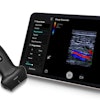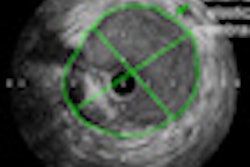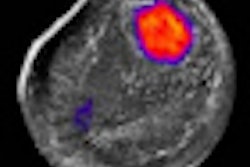Point-of-care ultrasound conducted by emergency medicine physicians may be a useful screening tool for evaluating acute appendicitis in children, according to research from Newark Beth Israel Medical Center in New Jersey.
The research team found that point-of-care ultrasound yielded 85% accuracy for evaluating appendicitis and can be a useful adjunct to clinical evaluation, according to Adam Sivitz, MD, director of pediatric emergency medicine education at Newark Beth Israel Medical Center.
He presented the findings at the American College of Emergency Physicians (ACEP) Research Forum in Las Vegas in September.
Acute appendicitis produces 80,000 cases a year and is the most common abdominal surgical emergency in children. Due to concerns over radiation exposure in children, ultrasound is the recommended first-line imaging modality for evaluating acute appendicitis, Sivitz said.
Sivitz noted that clinical scoring models for ruling out appendicitis have been published to help stage the order of imaging, placing ultrasound before CT.
"However, these models have ignored the obvious trend in emergency medicine to utilize point-of-care ultrasound, which is now part of emergency medicine resident curriculum and even beginning to get taught at the medical school level," Sivitz told AuntMinnie.com.
"Many people in [emergency medicine] who regularly do ultrasound have been anecdotally looking at the right lower quadrant, and a few places have published manuscripts or abstracts for this in the adult population," he said. "We think that children would benefit the most from [right lower quadrant] point-of-care ultrasound because of a more ultrasound-friendly body habitus and the greater risks associated with radiation exposure in childhood."
Seeking to determine the accuracy of emergency physician bedside ultrasound for suspected appendicitis in children, the research team is conducting a prospective observational study at an urban, academic pediatric emergency department. The study includes patients ages newborn to 21, who presented to the pediatric emergency department with a clinical suspicion for acute appendicitis and had received an order for a radiology ultrasound, CT, or surgical consult.
Of the 67 patients included in the study so far, 67% were male. The average age was 11.7 years, with a range of 4.1 to 20.9 years.
Patients were excluded if they had prior abdominal surgery, an inability to tolerate the examination, or a prior definitive imaging study, according to the researchers.
Ultrasound-trained emergency medicine physicians or pediatric emergency physicians used an M-Turbo (SonoSite, Bothell, WA) scanner with 10-5 MHz or 5-2 MHz curved-array probes to perform the point-of-care ultrasound studies, and the digital images and video were recorded for review. One hour of didactic training and hands-on training was provided.
A 100-mm visual analog scale (VAS) was used to provide the clinical likelihood score for appendicitis and also for the ultrasonographer's confidence in their findings. All interpretations were recorded at the time of examination, according to the researchers.
Findings were later compared with radiology results. For the purposes of the study, surgical pathology was used as the gold standard for diagnosis of acute appendicitis.
The researchers followed up normal cases by searching electronic medical records and by a phone call no earlier than one week after discharge.
Of the 67 patients, 28 (42%) had pathology-proven appendicitis. The emergency medicine physician was able to visualize the appendix in 56% of the cases.
Overall accuracy was 85%, with 82% sensitivity and 87% specificity, Sivitz said. The positive likelihood ratio was 6.4, with a range of 2.8 to 14.8, and the negative likelihood ratio was 0.2, with a range of 0.09 to 0.45.
That performance was pretty good, considering they're not radiologists, Sivitz said. And every ultrasonographer -- Sivitz, two other emergency medicine attendings, and six pediatric emergency medicine fellows -- were new to performing these appendicitis scans, he said.
"Our accuracy was actually better than the radiology ultrasound," he said.
The main implication of the study will be that emergency medicine physicians do not always need labs or a surgical consultation, or to wait for radiology, if a patient is suspected of having acute appendicitis, Sivitz said.
"Just like with free fluid in blunt abdominal trauma, gallstones, intrauterine pregnancy, pericardial effusions, or cardiac standstill, once you see it is positive, you are done with the workup," Sivitz said. "We would like to create a relationship with the surgeons and radiologists where our findings are part of the overall process, i.e., if the ultrasound study is obviously positive, then the surgeons go to the OR [like focused abdominal sonography in trauma (FAST) studies]."
The researchers are continuing to enroll patients in the study and are adding more junior sonographers. Sivitz said the next step is to look at outcomes findings such as potential time and resource savings, as well as the level of training needed to gain proficiency.
By Erik L. Ridley
AuntMinnie.com staff writer
November 5, 2010
Related Reading
Surgery residents accurately diagnose appendicitis with ultrasound, October 6, 2010
For pediatric appendicitis, ultrasound cuts radiation, saves time over CAT scans, September 29, 2010
Preoperative CT helps reduce negative appendectomies, June 22, 2010
Appendicitis: Positive CT outweighs lack of symptoms, May 27, 2010
Large study confirms CT's accuracy for acute appendicitis, May 20, 2010
Copyright © 2010 AuntMinnie.com




















